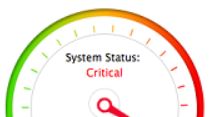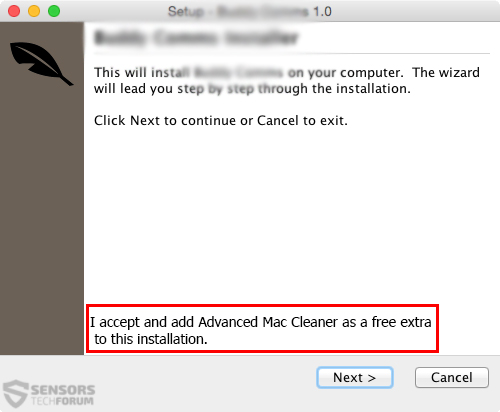PUP.MacOS.AdvancedMacCleaner is a rogue software pretending to be a Mac cleaner has been reported to affect users via bundling and display to them overpriced rates to purchase the licensed version.
The software is called Advanced Mac Cleaner and it was also reported to pretend to find opportunities to clean up the affected device’s memory, however these are believed to be false positives. All users who have identified Advanced Mac Cleaner should immediately download a particular anti-malware tool to assist them in removing advanced Mac Cleaner effectively.

Threat Summary
| Name | Advanced Mac Cleaner also known as PUP.MacOS.AdvancedMacCleaner.hlp and PUP.MacOS.AdvancedMacCleaner.CA |
| Type | Rogue PC Cleaner |
| Short Description | The PUA(Potentially Unwanted Application) may display false errors on your Mac Book and demand funds for licensed version that removes them. |
| Symptoms | The user may witness PC slowdowns, automatic scans and prompts for activation. |
| Distribution Method | Bundled Installers. |
| Detection Tool |
See If Your System Has Been Affected by malware
Download
Malware Removal Tool
|
| User Experience | Join our forum to Discuss Advanced Mac Cleaner . |

Advanced Mac Cleaner – How Is It Spread?
PUP.MacOS.AdvancedMacCleaner is pretending to be a Mac cleaner. The software is believed to be downloaded on user PCs via several different third-party websites that may distribute it along the installers of other programs, for example:
This is why users are strongly advised to be extremely careful around installers of free software like PUP.MacOS.AdvancedMacCleaner they download from locations that are not trusted. It is a good practice to always choose the “Custom” or “Advanced” installation options and look for programs like Advanced Mac Cleaner that may pretend to be “free extras”.

Advanced Mac Cleaner In Detail
As soon as I enters your computer, Advanced Mac Cleaner creates the following file:
- amc_msite.pkg
After creating this file the program may begin scanning your computer, taking up system resources and making it slower:
After the automatic scan is completed, Advanced Mac Cleaner may pretend to display several different types of errors that may not be existent on your Mac book.
The errors may be from different functions of the system, such as:
- Cache manager.
- Logs manager.
- Trash manager.
- Extra languages.
- Rogue apps.
When the user tries to remove the detected errors by clicking on the “Clean Now” button, the software displays a prompt for paying the sum of around 10$ to activate the licensed version.
Researchers strongly advise users against purchasing this version of PUP.MacOS.AdvancedMacCleaner because even though it claims to have a 60 day money back guarantee, you may not receive your payment back. Not only this, but the software may also create errors on your Mac Book that slow it down to further convince you to purchase its license.

Remove Advanced Mac Cleaner
In order to delete PUP.MacOS.AdvancedMacCleaner, users are strongly advised to follow the instructions below to remove it manually. However, since Advanced Mac Cleaner can also modify other aspects of your computer, make sure to use an advanced anti-malware tool for maximum effectiveness of the removal.
Steps to Prepare Before Removal:
Before starting to follow the steps below, be advised that you should first do the following preparations:
- Backup your files in case the worst happens.
- Make sure to have a device with these instructions on standy.
- Arm yourself with patience.
- 1. Scan for Mac Malware
- 2. Uninstall Risky Apps
- 3. Clean Your Browsers
Step 1: Scan for and remove Advanced Mac Cleaner files from your Mac
When you are facing problems on your Mac as a result of unwanted scripts and programs such as Advanced Mac Cleaner, the recommended way of eliminating the threat is by using an anti-malware program. SpyHunter for Mac offers advanced security features along with other modules that will improve your Mac’s security and protect it in the future.

Quick and Easy Mac Malware Video Removal Guide
Bonus Step: How to Make Your Mac Run Faster?
Mac machines maintain probably the fastest operating system out there. Still, Macs do become slow and sluggish sometimes. The video guide below examines all of the possible problems that may lead to your Mac being slower than usual as well as all of the steps that can help you to speed up your Mac.
Step 2: Uninstall Advanced Mac Cleaner and remove related files and objects
1. Hit the ⇧+⌘+U keys to open Utilities. Another way is to click on “Go” and then click “Utilities”, like the image below shows:

2. Find Activity Monitor and double-click it:

3. In the Activity Monitor look for any suspicious processes, belonging or related to Advanced Mac Cleaner:


4. Click on the "Go" button again, but this time select Applications. Another way is with the ⇧+⌘+A buttons.
5. In the Applications menu, look for any suspicious app or an app with a name, similar or identical to Advanced Mac Cleaner. If you find it, right-click on the app and select “Move to Trash”.

6. Select Accounts, after which click on the Login Items preference. Your Mac will then show you a list of items that start automatically when you log in. Look for any suspicious apps identical or similar to Advanced Mac Cleaner. Check the app you want to stop from running automatically and then select on the Minus (“-“) icon to hide it.
7. Remove any leftover files that might be related to this threat manually by following the sub-steps below:
- Go to Finder.
- In the search bar type the name of the app that you want to remove.
- Above the search bar change the two drop down menus to “System Files” and “Are Included” so that you can see all of the files associated with the application you want to remove. Bear in mind that some of the files may not be related to the app so be very careful which files you delete.
- If all of the files are related, hold the ⌘+A buttons to select them and then drive them to “Trash”.
In case you cannot remove Advanced Mac Cleaner via Step 1 above:
In case you cannot find the virus files and objects in your Applications or other places we have shown above, you can manually look for them in the Libraries of your Mac. But before doing this, please read the disclaimer below:
1. Click on "Go" and Then "Go to Folder" as shown underneath:

2. Type in "/Library/LauchAgents/" and click Ok:

3. Delete all of the virus files that have similar or the same name as Advanced Mac Cleaner. If you believe there is no such file, do not delete anything.

You can repeat the same procedure with the following other Library directories:
→ ~/Library/LaunchAgents
/Library/LaunchDaemons
Tip: ~ is there on purpose, because it leads to more LaunchAgents.
Step 3: Remove Advanced Mac Cleaner – related extensions from Safari / Chrome / Firefox









Advanced Mac Cleaner-FAQ
What is Advanced Mac Cleaner on your Mac?
The Advanced Mac Cleaner threat is probably a potentially unwanted app. There is also a chance it could be related to Mac malware. If so, such apps tend to slow your Mac down significantly and display advertisements. They could also use cookies and other trackers to obtain browsing information from the installed web browsers on your Mac.
Can Macs Get Viruses?
Yes. As much as any other device, Apple computers do get malware. Apple devices may not be a frequent target by malware authors, but rest assured that almost all of the Apple devices can become infected with a threat.
What Types of Mac Threats Are There?
According to most malware researchers and cyber-security experts, the types of threats that can currently infect your Mac can be rogue antivirus programs, adware or hijackers (PUPs), Trojan horses, ransomware and crypto-miner malware.
What To Do If I Have a Mac Virus, Like Advanced Mac Cleaner?
Do not panic! You can easily get rid of most Mac threats by firstly isolating them and then removing them. One recommended way to do that is by using a reputable malware removal software that can take care of the removal automatically for you.
There are many Mac anti-malware apps out there that you can choose from. SpyHunter for Mac is one of the reccomended Mac anti-malware apps, that can scan for free and detect any viruses. This saves time for manual removal that you would otherwise have to do.
How to Secure My Data from Advanced Mac Cleaner?
With few simple actions. First and foremost, it is imperative that you follow these steps:
Step 1: Find a safe computer and connect it to another network, not the one that your Mac was infected in.
Step 2: Change all of your passwords, starting from your e-mail passwords.
Step 3: Enable two-factor authentication for protection of your important accounts.
Step 4: Call your bank to change your credit card details (secret code, etc.) if you have saved your credit card for online shopping or have done online activiites with your card.
Step 5: Make sure to call your ISP (Internet provider or carrier) and ask them to change your IP address.
Step 6: Change your Wi-Fi password.
Step 7: (Optional): Make sure to scan all of the devices connected to your network for viruses and repeat these steps for them if they are affected.
Step 8: Install anti-malware software with real-time protection on every device you have.
Step 9: Try not to download software from sites you know nothing about and stay away from low-reputation websites in general.
If you follow these reccomendations, your network and Apple devices will become significantly more safe against any threats or information invasive software and be virus free and protected in the future too.
More tips you can find on our MacOS Virus section, where you can also ask any questions and comment about your Mac problems.
About the Advanced Mac Cleaner Research
The content we publish on SensorsTechForum.com, this Advanced Mac Cleaner how-to removal guide included, is the outcome of extensive research, hard work and our team’s devotion to help you remove the specific macOS issue.
How did we conduct the research on Advanced Mac Cleaner?
Please note that our research is based on an independent investigation. We are in contact with independent security researchers, thanks to which we receive daily updates on the latest malware definitions, including the various types of Mac threats, especially adware and potentially unwanted apps (PUAs).
Furthermore, the research behind the Advanced Mac Cleaner threat is backed with VirusTotal.
To better understand the threat posed by Mac malware, please refer to the following articles which provide knowledgeable details.







